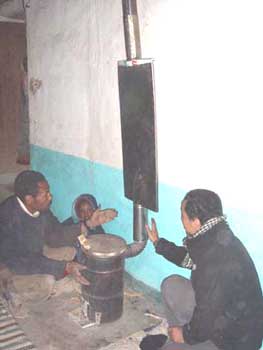
 |
|
IMPROVED CHIMNEY
|
Dear stove list members,
I am looking for suggestions on how to evaluate the performance of heat-exchanger chimney.
A wood heating stove with a 10cm diameter tin chimney has an exit temperature (measured at chimney center, right below roof) of 300oC. Using the same stove with an 'improved' (heat exchanger) chimney (a narrow rectangular section), the exit temperature dropped to 160oC. In both case, the burn rate remained roughly the same, 2 Kg of wood per hour.
Question: For same amount of heat released indoor, how much wood is saved by this improved chimney?
See photo of improved chimney above.
Chimney Draft Calculator:
I am wondering if the Nigel-Pemberton-Pigott calculator (excel spreadsheet in this stoves website) does apply to this case. I used this calculator to evaluate how much hot air is escaping through the chimney [assumed Air factor : 100%, 0.004 m^3 / s at 160oC and 0.006 m^3/s 300oC); using the air density and its specific heat, I determine how much heat was lost to outdoor for each chimney exit temperature (1000 J/s at 160oC; 1600 J/s at 300oC); then, I compared the difference of heat loss to outdoor (600 J/s) to total combustion energy (2Kg wood/hour: 11000 J/s). I get chimney peformance (heat saved relative to total heat in wood) of 5%.
Well, I hope I am making a mistake somewhere! and that the chimney is more efficient than 5%!
Thank you very much for any suggestion or comment.
Mouhsine Serrar
----------------
Background:
========
I am working on a biomass conservation project for the Global Environment Fund in
The cylindrical chimney had a diameter of 10 cm, and was three meters high.
The goal from designing this improved chimney is to extract as much heat as possible from hot gases escaping through chimney, using a low cost chimney (cost target: $5). For this purpose, a narrow rectangular chimney (2cm x 40cm rectangle; same cross section area as original chimney; length: 2m) was used. This narrow chimney has a larger heat transfer area ( 2.7 times larger), and hottest gases at center of the flow section are closer to chimney surface. Such section should increase the amount of heat extracted from hot gases and released indoor.
Thanks!
Mouhsine Serrar
Chimney Draft Calculator and Stove Modelling Spreadsheet, Crispin Pemberton-Pigott, New Dawn Engineering, October 2004
UNDP Global Environment Facility SMALL GRANTS PROGRAMME
Atlas Mountain Images from Hommes et Montagnes http://www.hommes-et-montagnes.fr/ (People and Mountain) website
Le Centre de Développement des Energies Renouvelables (CDER) Moroccan Center for Renewable Energy Development, Marrakech